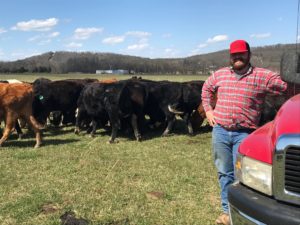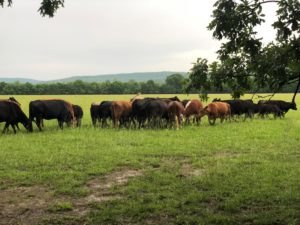
McKenzie Fanning grew up with the dream of becoming a cattleman. He started his operation with an FSA youth loan and continues to utilize FSA farm loans to build his business.
By Nicole Gurley, Farm Loan Officer, Washington County, Arkansas
McKenzie Fanning grew up in Westfork, Arkansas, with the dream of becoming a cattleman. Although the 21-year old wasn’t raised on a farm, he had memories of his grandparent’s farm, including the time when he made a trade with his grandfather: a pig for a heifer, opening his path to the cattle business.
He started saving his money from doing chores and after some time he was able to purchase another heifer. At just 15, Fanning came to the USDA Farm Service Agency (FSA) and was able to obtain a loan which he used to purchase three cow/calf pairs that he kept on his grandfather’s land.
“FSA has 100 percent allowed me to start my dream,” Fanning said. “I want to run my cattle operation like a business.”
FSA youth loans are available to individuals between the ages of 10 and 21 to start and operate income-producing projects in connection with their participation in 4-H, the National FFA Organization, a tribal youth group, or other similar agricultural youth organization. These loans provide an opportunity for young entrepreneurs to acquire experience and education in agriculture.
Fanning’s parents and grandparents have always been very supportive. His grandfather has been a cattleman for 60 years. To help his grandson, Fanning’s grandfather allows him to use his equipment for haying in the summer and for feeding cattle year-round. When Fanning leans on his grandfather for advice, he gives him tough love and tells him “you can learn the hard way.”

McKenzie Fanning, 21, relied on friends and fellow cattlemen to help learn the ropes of the cattle business.
“I’ve relied on friends and cattlemen in the area to answer my questions and have spent time with them working cattle and learning valuable business skills,” he said.
Fanning also worked through FSA to get a microloan to purchase additional cattle.
FSA’s microloan program meets the financial operating needs of new, niche, and small to mid-sized family farm operations. Through microloans, farmers may borrow up to $50,000 using an abbreviated application process.
Looking back at how the markets were at the time Fanning said this may have been a costly decision.
“Cattle were too high to pay for themselves and they can always go down,” he said.
Ready to expand his operation even more, he leased 210 acres to put cattle on. This brought a new challenge, too many acres for the number of cattle he was running at that time. He knew he needed more cattle to fully utilize the leased pasture.
This brought him back to FSA in 2016, this time the FSA farm operating loan was the best fit for his farm. He was able to purchase the right number of cattle for the land, allowing for both responsible land stewardship and economical agricultural production, making the lease feasible.
Aside from his role as a cattleman, Fanning is an electrician at a local business.
“I am using my job as a stepping stone,” he said. “My goal is to have my own business and get my cattle paid for, then be able to purchase a farm.”
And yes, FSA has a program to help him with that too.
For more information on FSA’s farm loan programs, visit your local county FSA office or www.fsa.usda.gov. Locate your local office at offices.usda.gov.





